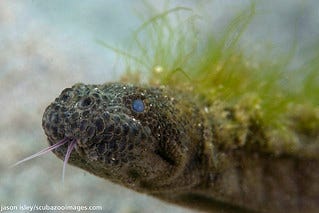GOOD day: How do you get biogas from seaweed biomass?
The Paxtier report 02/03/22: Featuring climate market updates, Patrick Sieb and the US$38 billion microalgae play.
“It always seems impossible until it's done”
— Nelson Mandela
Hello and welcome to Paxtier’s weekly roundup for Wednesday, March 2, 2022! This week we bring you updates on IPCC II, Patrick Sieb from Investible, and Ray Dalio on war-time markets.
Markets
In general, following Russia’s invasion of Ukraine, global venture funding announcements have slowed. In fact, only 154 companies across the globe have revealed a seed, early- or late-stage venture investment of disclosed size since the attack began. Despite this, there was so much happening in algae this week, and sentiment remains positive! For example, Phykos, a company growing seaweed on mobile autonomous platforms, sought their first software engineer. Then, Lallemand announced their involvement in SCALE, the world’s largest microalgae biorefinery project. This was followed by bulls predicting a US$ 18.1 Bn 2028 microalgal market, and the company Simris chasing a piece of Fermentalg’s 105 MEUR market cap (18.8x sales multiple). Clearly, international investors are keen to join the algal party, and the week was topped off with Next Generation Oil calling on local manufacturers to join in on its new US$38 billion microalgae cultivation play.
Paxtier’s Top Algae-tech News
IPCC issues ‘bleakest warning yet’ on impacts of climate breakdown: This is the second part of the IPCC’s latest assessment report, an updated, comprehensive review of global knowledge of the climate, which has been seven years in the making and draws on the peer-reviewed work of thousands of scientists. Some key points revolve around the fact key ecosystems are losing their ability to absorb carbon dioxide, and some countries have agreed to conserve 30% of the Earth’s land, but conserving half may be necessary to restore the ability of natural ecosystems to cope with the damage wreaked on them.
Next Generation Oil seeks local vendors for role in multibillion ringgit algae project: “We need 15 million tanks to cultivate algae over the next 10 years, which will produce 68 million tonnes of algae biomass, absorb about 76 million tonnes of CO2 and produce 34 million tonnes of crude algae oil and dry algae cake. We want to help make Malaysia net-zero carbon before 2050 and the volume of micro algae we are cultivating will create a natural carbon sink,”NGOG executive chairman, Datuk Indera Mohamed Moiz told reporters after the launch of the programme.
Mazda 2 Bio concept to race in Super Taikyu Series – biodiesel from used cooking oil, edible microalgae: The Mazda 2 Bio concept is the familiar B-segment hatch equipped with a Skyactiv-D diesel engine, but it uses a 100% biomass-derived next-generation biodiesel fuel called Susteo offered by a company called Euglena.
Lallemand takes part in SCALE, the world’s largest microalgae biorefinery project: The SCALE project strives to build and operate a first-of-its-kind flagship plant to valorize on an industrial scale natural active ingredients derived from microalgae for various high-valuated end-use sectors. It is led by Microphyt, a leading company in the production and marketing of microalgae-based bioactive ingredients based in France.
Using Ethanol emission to cultivate algae: Argonne study shows that carbon emissions that come from making ethanol can cultivate algae which in turn can be used to make biofuel.
Tweets of the week
A review by Zheng et al. investigated recent advances in bioutilization of marine macroalgae carbohydrates: This work describes the latest research results concerning green degradation, biorefining, and metabolic pathway design, including summarizing the latest biorefining technology and the fermentation platform design of agarose, alginate, and other polysaccharides. The information will provide new research directions and solutions for the biotransformation and utilization of marine macroalgae.
Eight Seaweed Species are evaluated for their potential use as an alternative for biofuel production and source of bioactive compounds: Porphyra purpurea presented a balanced composition in terms of carbohydrates and proteins and the best thermochemical profile. This species also showed moderate anti-inflammatory activity. Additionally, Himanthalia elongata extracts showed the highest contents of total phenolics and a moderate carotenoid content, which led to the highest rates of antioxidant activity.
dMY Technology IV : Planet Launches Next Generation PlanetScope with Eight Spectral Bands and Quality Improvements: Early access users of next-generation PlanetScope Monitoring have been able to leverage these enhancements to support environmental monitoring and protect human health in coastal communities. SargAssure, a UK Space Agency-funded project, currently uses the spectral data to monitor large influxes of seaweed, known as sargassum, as it washes up onto coastal beaches. As large piles of the seaweed decompose, they release harmful chemicals that can cause respiratory and skin issues for beach-goers; this has prompted organizations to now monitor and provide early-warning systems for local communities.
Nordic Seafarm raises $2 million in latest funding round: Sweden’s foodtech company Nordic SeaFarm has raised 2 million euros in the latest funding round supported by JCE Ventures, Almi Invest, and Kale United to become Europe’s largest producer of plant-based seafood.
BLOOM Sustainable Materials Surpass One Billion Liters of Water Cleaned: Over 17M pairs of shoes were produced in 2021 using BLOOM Materials. This resulted in over 500 million liters of cleaned water. BLOOM Sustainable Materials transforms waste biomaterials, like algae, into award-winning renewable and restorative materials used to make footwear and other consumer products.
China’s first artifical upwelling demonstration project gets a thumbs up: In this project, an artificial system is installed to form seawater upwelling, which can transport nutrient-rich seawater to the euphotic layer on the surface. In this way, the growth of phytoplankton and algae can be promoted, thereby improving primary productivity, restoring the marine ecological environment, and enhancing marine carbon sinks. As estimated, the total grand of increased carbon sinks will add up to over 4.9 million tons (in terms of CO2), and more than 13,900 tons of nitrogen and 2,130 tons of phosphorus will be removed if the upwelling scheme is implemented in 140,000 hectares of seaweed farmland.
Pretreatment techniques of seaweed for biogas get a review: This study systematically summaries the novel techniques and chemicals used for physical, thermal, chemical and thermochemical pretreatments of lignocellulosic materials for the enhancement of anaerobic digestion. It concludes that physical pretreatments are very costly, while chemical pretreatments are efficient but polluting, and both are limited by high energy consumption.
In depth with Peter Green
How do you get biogas from seaweed biomass?
As the price of oil skyrockets, it’s clear that the world needs new, sustainably sourced fuels to power our future. It might seem far-fetched, but for decades now a growing body of research has indicated one organism in particular could offer a suitable alternative: seaweed. This fast-growing renewable resource has been making quite a racket in the renewables space, with some recent forecasts even predicting that seaweed-derived biofuels could replace up to 20% of fossil fuel demand by 2050.
Anaerobic digestion is one promising method for exploiting bioenergy from seaweed biomass, and consists of a series of actions by different groups of bacteria that convert organic compounds to methane, carbon dioxide and bacterial cells. The biogas produced from the AD of seaweed typically contains methane 50–70%, carbon dioxide 30–45%, hydrogen <2% and hydrogen sulphide <3.5%.
SO… why haven’t we seen more of it??
As is the case with many climate solutions, technological challenges are rife. In the case of AD of seaweeds, major bottlenecks include (but are not limited to:)
The rigidity of the seaweed cell wall and presence of high molecular weight organic compounds hinders cell disintegration during the hydrolysis step.
Seaweed biomass houses several inhibitory compounds which can limit the methanogenesis step.
Biomethane production is affected by seasonality. For example, Irish seaweed harvested in the summer season shows high polyphenolic content, which lowers biogas production.
Investible: Patrick Sieb
Patrick Sieb from Investible is no stranger to climate tech. Now leading the Investible Climate Tech Fund , he recently sat down with us to discuss his journey so far, his role at the new fund and common challenges he’s observed in the space.
What does Investible's Climate Tech Fund focus on?
“This is a $100 million climate tech fund looking to invest in start-ups which impact the climate positively. As a result, these start-ups must directly or indirectly reduce emissions, or create adaptation benefits. Despite our global mandate, we are particularly interested in making Asia-Pacific early-stage investments, as we see great potential in this region.
In terms of sector focus, considering our attention is on early-stage start-ups, diversification is key for our portfolio. As a result, we intend to invest in 60 companies which can solve problems in industry, transport, energy, food & agriculture, land & forest use, and buildings & cities.”
What common challenges do early-stage companies in this space struggle with?
“It's certainly hard to generalise due to the varying types of businesses that are in this sector. However, it is paramount that teams master the fundamental start-up skills and attitudes which drive success across all sectors. For example, it's critical that the founder and founding team have resilience, curiosity, and passion
“In addition, technology risk, adoption timing, and capital intensity can bring additional challenges for some climate tech companies. When it comes to fundraising, typical businesses gain favour by highlighting progress through revenue milestones, which is not possible in pre-revenue deep-tech companies. As a result, to attract investment these teams must show progress in another way. That's where they might focus their pitch more on scientific advancements and any progression through regulatory barriers. Understanding that forward momentum must be shown differently is important.
At Investible, we want to accelerate the time from seed to Series A. As a result, we help founders achieve their goals quickly without skipping any vital milestones which encourage later-stage funding and success.”
Ray Dalio on economic markets and war
Bridgewater Associates and Ray Dalio released a great article on how the world order is changing and the effect of war on the economic machine. I provide a few highlights below but encourage everyone to read the full report HERE.
As we wait to find out whether this war will expand or stop, the two most immediate questions are:
Will Russian responses to sanctions hurt countries beyond the Ukrainian-Russian borders?
How supportive will China be to Russia?
There are five major kinds of competitions or wars that exist between countries:
Trade/economic wars
Technology wars
Geopolitical wars
Capital wars
Military wars
They vary in severity from healthy competitions to all-out wars. The progression tends to be from the first one on the list (trade/economic wars) toward the last one on the list (military wars), with each growing in intensity.
To be a leading world power, one must be strong in most of the major ways. Russia is not strong in all ways, therefore it must align itself with a leading power (China) to win wars.
Shortly before there is a military war there is an economic war that typically includes:
Asset freezes/seizures
Blocking capital markets access
Embargoes/blockades
The choice that opposing countries face between fighting or backing down is very hard to make because both are costly.
Winning means getting the things that are most important without losing the things that are most important. As a result, wars that cost much more in lives and money than they provide in benefits are stupid. This looks like a stupid war.
It appears that we are in the “at the brink” part of the cycle that is just after the big intensification of the economic war attacks and just before the military hot war. However, Dalio states a full scale war is still improbable.
Gold—or, in some cases, silver or barter—has historically been the coin of the realm during wars. At such times, prices and capital flows are typically controlled, so it is difficult to say what the real prices of many things are.
Because losing wars typically leads to a total wipeout of wealth and power, movements of those stock markets that remained open in the war years were largely driven by how countries did in key battles as these results shifted the probability of victory or defeat for each side. When hot wars happen, classically it pays to sell out of debt and buy gold because wars are financed by borrowing and printing money, which devalues debt and money, and because there is a justifiable reluctance to accept credit.
Jobs:
1. Fully Funded Phd Scholarship Swansea: The Effect of Mineral Rich Algae With and Without Plant-Based Protein Supplementation on Endurance Exercise Performance (Rs75)
2. PhD position Leibniz: Present and past biodiversity characterization of selected marine biomes using eDNA
Liverpool winning the Carabao Cup:

Thanks again for joining us this week! Looking forward to seeing you soon.
Best,
Peter
Paxtier






















